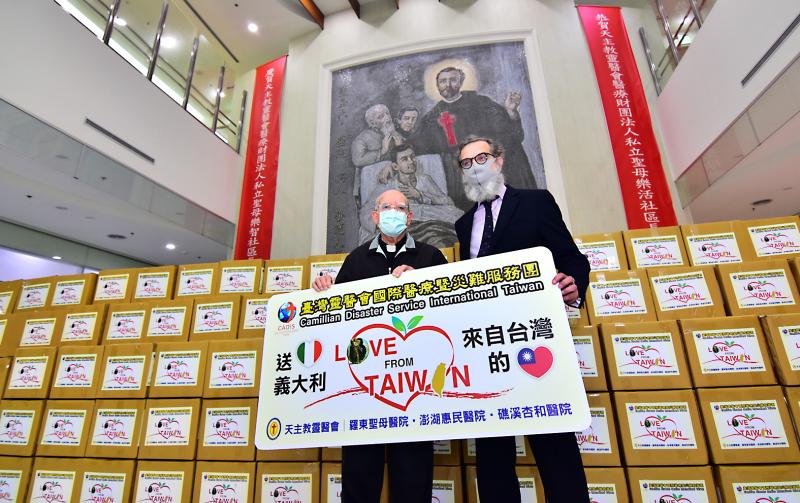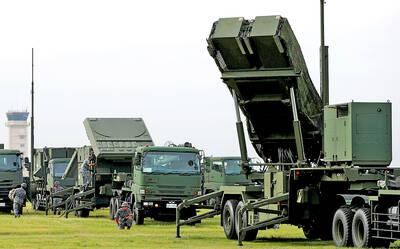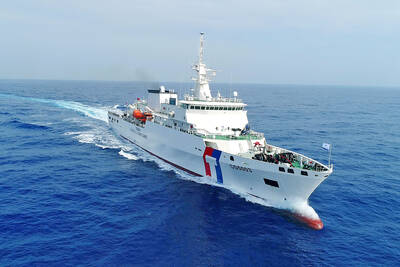The Central Epidemic Command Center (CECC) yesterday reported one new COVID-19 case, a cadet who had been aboard the navy supply ship Panshih (磐石) adding that the cadet tested positive in a second test, but had antibodies.
Between Saturday last week and Tuesday, the center reported 27 confirmed cases who were crew members of the Panshih, one of the three vessels making up a “Friendship Flotilla” that visited Palau.
After the first case was confirmed on Saturday, all 744 officers, sailors and cadets on board the three vessels were recalled for testing and ordered into quarantine for 14 days.

Photo: Chang Yi-chen, Taipei Times
From March 23, the cadet, in his 20s, started coughing, developed a fever and experienced a loss of smell, but his condition improved after taking medicine, said Minister of Health and Welfare Chen Shih-chung (陳時中), who heads the center.
The cadet tested negative after arriving at a quarantine facility on Saturday, but after having a stuffy nose and losing his sense of smell on Sunday, he was given another test, which came back positive yesterday, Chen said.
Five crew members who sought treatment for fever from the Panshih’s medical officer between March 21 and March 26 had antibody blood tests at the quarantine center, CECC advisory specialist panel convener Chang Shan-chwen (張上淳) reported on Monday, adding that three of them had antibodies, but tested negative.

Photo: Liao Chen-huei, Taipei Times
The new case was one of the people who had antibodies, but he tested positive in the second examination, Chang said.
After the body of an infected person begins to produce antibodies, the virus usually weakens, but might not immediately disappear, so there might be a period in which both the antibodies and the virus can be detected, he said.
People with the antibody and the virus are likely to test negative sometimes and positive other times — but the virus is typically more difficult to culture at this stage, so the risk of such people transmitting the virus to others is lessened, Chang said.
Asked about some countries wanting to conduct wide-scale antibody testing so that people with immunity could return to work, Chang said that the concept has a scientific base, as people with antibodies are believed to be safe from contracting the virus again.
However, whether people who have the antibody and the virus at the same time can infect others needs further study, Chang said.
So far, 28 COVID-19 cases have been confirmed among crew members of the Panshih and 692 people have been identified as having had direct contact with them, Chen said, adding that 446 of those identified have been placed in home quarantine and 246 of them were practicing self-health management.
Department of Medical Affairs Director-General Shih Chung-liang (石崇良) said that 229 Taiwanese from China’s Hubei Province and 14 crew landed in Taiwan on a “quasi-charter flight” from Shanghai at about 9:15pm on Tuesday.
One passenger had a mild fever and respiratory symptoms. They were isolated and tested, but the results came back negative, he said, adding that the other passengers were settled in quarantine facilities and received their first test.
All 231 Taiwanese who arrived on a quasi-charter flight from China’s Hubei Province on Monday evening tested negative in the first test, he added.

MILITARY BOOST: The procurement was planned after Washington recommended that Taiwan increase its stock of air defense missiles, a defense official said yesterday Taiwan is planning to order an additional four PAC-3 MSE systems and up to 500 missiles in response to an increasing number of missile sites on China’s east coast, a defense official said yesterday. The official, who spoke on condition of anonymity, said that the proposed order would be placed using the defense procurement special budget, adding that about NT$1 trillion (US$32,88 billion) has been allocated for the budget. The proposed acquisition would include launchers, missiles, and a lower tier air and missile defense radar system, they said The procurement was planned after the US military recommended that Taiwan increase

POLITICAL AGENDA: Beijing’s cross-strait Mid-Autumn Festival events are part of a ‘cultural united front’ aimed at promoting unification with Taiwan, academics said Local authorities in China have been inviting Taiwanese to participate in cross-strait Mid-Autumn Festival celebrations centered around ideals of “family and nation,” a move Taiwanese academics said politicizes the holiday to promote the idea of “one family” across the Taiwan Strait. Sources said that China’s Fujian Provincial Government is organizing about 20 cross-strait-themed events in cities including Quanzhou, Nanping, Sanming and Zhangzhou. In Zhangzhou, a festival scheduled for Wednesday is to showcase Minnan-language songs and budaixi (布袋戲) glove puppetry to highlight cultural similarities between Taiwan and the region. Elsewhere, Jiangsu Province is hosting more than 10 similar celebrations in Taizhou, Changzhou, Suzhou,

TWO HEAVYWEIGHTS: Trump and Xi respect each other, are in a unique position to do something great, and they want to do that together, the US envoy to China said The administration of US President Donald Trump has told Chinese President Xi Jinping (習近平) “we don’t want any coercion, but we want [the Taiwan dispute] resolved peacefully,” US ambassador to China David Perdue said in a TV interview on Thursday. Trump “has said very clearly, we are not changing the ‘one China’ policy, we are going to adhere to the Taiwan Relations Act, the three communiques and the ‘six assurances’ that were done under [former US president Ronald] Reagan,” Perdue told Joe Kernen, cohost of CNBC’s Squawk Box. The act, the Three Joint Communiques and the “six assurances” are guidelines for Washington

DEEPENING TIES: The two are boosting cooperation in response to China’s coercive actions and have signed MOUs on search-and-rescue and anti-smuggling efforts Taiwan and Japan are moving to normalize joint coast guard training and considering the inclusion of other allies, the Japanese Yomiuri Shimbun reported yesterday. Both nations’ coast guards in June sent vessels to the seas south of the Sakishima Islands to conduct joint training, the report said, adding that it was the second joint maritime training exercise since the nations severed formal diplomatic ties in September 1972. Japan dispatched the Nagoya Coast Guard’s Mizuho, a 134m, 6,000-tonne patrol vessel which can carry a helicopter, while the Coast Guard Administration (CGA) sent the 126m, 4,000-tonne Yunlin, one of its largest vessels, the report